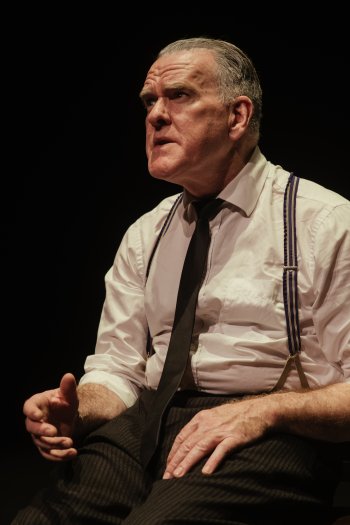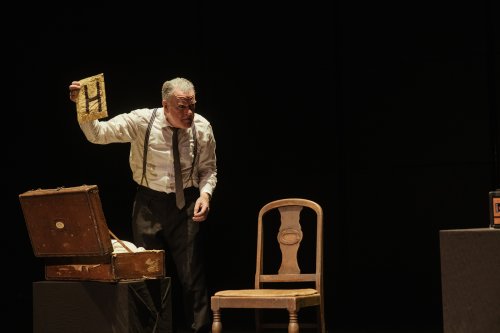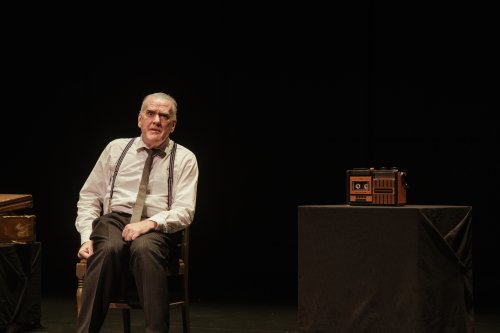The Mysterious Case of Kitsy Rainey
The final tale in a trilogy on the life of a mute cobbler Pat Farnon and his wife Kitsy Rainey in the town of Sligo, Ireland, as his life is slowly coming to an end.

Mikel Murfi in a scene from his one-man show “The Mysterious Case of Kitsy Rainey” at the Irish Arts Center (Photo credit: Gili Benita)
[avatar user=”Scotty Bennett” size=”96″ align=”left”] Scotty Bennett, Critic[/avatar]
The Mysterious Case of Kitsy Rainey, written, directed and performed by Mikel Murfi, is the final tale in a trilogy on the life of a mute cobbler Pat Farnon and his wife, Kitsy Rainey in the town of Sligo, Ireland. This story is an homage to Pat’s dead wife Kitsy as his life is slowly coming to an end.
Mikel Murfi skillfully brings to life a handful of colorful characters in a rural town where Farnon is the cobbler. The transitions from one character to the next are done with shifts in posture and tone of voice that imbues each transition with the physical and verbal nuances that define the character. It is an interesting tale, rough in places and a bit too long in exposition, but well told by a seasoned actor whose performance is worth spending time on.
The show opens on a dark stage with a drum sound made by someone’s voice. A man’s voice begins to speak out a jumble of words that jump from idea to idea without a clear connection. The light slowly comes up on the speaker. It is a struggle to make sense of what is being spoken.
PAT: I can’t talk, I can’t talk and now that I can hardly see either…/WILL YE MOVE FOR CRYING OUT LOUD WILL YE MOVE…/and that’s what we do when we’re safe at home, by candle light…/
Or later in the same opening sequence.
PAT: …She has hit him, she has hit him and the linesman is on his back … A RED CARD FOR KITSY RAINEY …/ We’ll not take life too seriously Pat, it’s not as if we’re getting out alive …/ Hear the lark in the clear air …/

Mikel Murfi in a scene from his one-man show “The Mysterious Case of Kitsy Rainey” at the Irish Arts Center (Photo credit: Gili Benita)
At the end of the opening soliloquy, Murfi stands in the center of the stage as the person making the drumming sounds, and he switches to the announcer for a talent show and then two other characters, Huby and Jimmy, as the announcer introduces Pat Farnon. As Murfi goes to a small table with a suitcase on top, he transitions into an old man with stooped shoulders and a shuffling gait. He lifts the case, lays it on its side, and opens it. He then turns and speaks to the audience. He is now Pat Farnon in the living room of his house, beginning a tale about his dead wife, Kitsy Rainy, and the mysteries in her suitcase. He tells us that what is being spoken is his thoughts that can only be heard by the people listening to this story.
Kitsy had been dead for a few years as Pat tells us about the mystery surrounding the suitcase. She told Pat that the story of her life before she met him was in the suitcase but he could not open the suitcase until after she died. Once she died, he could not bring himself to open it, but now, as he was moving towards his end, he decided it was necessary.
The play moves back and forth in time, taking the audience through Pat’s struggles with his loss of Kitsy and his fear of opening the suitcase. When he does, the first thing he finds is a cassette tape. He puts the tape in a player and pushes play. Kitsy now becomes a critical character in the show as she guides Pat through her decisions on making the tape and telling her story.
Murfi has created a story that presents the deep feelings and understanding that developed between Pat and Kitsy through the years before and after they married. The shifts in time are connected to his listening to the tape. Listening to the tape is a flashback to the past, and when the machine is turned off, Pat explains how he was reacting when he first heard it. The show is a story within a story. While Kitsy’s life is being revealed, so is the life of Pat, both present and past.
The character Huby, introduced at the beginning of the play in the talent show dialogue, plays an essential part in the story by adding information about Pat that increases the understanding of him and Kitsy, especially at the end. He is Pat’s best friend and someone whom Kitsy trusted completely.

Mikel Murfi in a scene from his one-man show “The Mysterious Case of Kitsy Rainey” at the Irish Arts Center (Photo credit: Gili Benita)
The meaning of the talent show at the beginning of the story becomes clear at the end of the tape from Kitsy. It involves something that Kitsy left in the suitcase for Pat; she calls it a gift, and Pat uses it in the talent show.
Murfi does a marvelous job of putting on the different characters as he unwraps the story of the end times of both Kitsy Rainey and Pat Farnon. While the story is tender, heartfelt, and, at times, funny, some of the expositions are too long to support the main thrust of the action adequately.
In addition, some of the expressions used may not be understandable to American audiences, such as the title. Most American speakers consider a “case” to relate to law or beer and soda, so when something is referred to as “the mysterious case,” what immediately comes to mind is a legal mystery, not a suitcase.
The set is bare-bones, with small tables and a chair with two important visible props, a cassette player, and a suitcase. There are two critical technical elements in the staging: sound and lighting. Jack Cawley does an exceptional job coordinating the spoken and taped dialogue. Nick McCall’s lighting is crucial for maintaining the flow of the action while Murfi is shifting from character to character.
The Mysterious Case of Kitsy Rainey (through November 18, 2023)
Loco & Reckless Productions
Irish Arts Center, 726 11th Avenue, between 51st & 52nd Streets, in Manhattan
For tickets, visit https://tickets.irishartscenter.org/1677/1684
Running time: 90 minutes without an intermission






Leave a comment